I just completed my annual task of going through the many books I’ve read during the year and deciding which ones I’ll add to my personal collection. Since moving into a tiny apartment four years ago, my goal has been to keep only 10 books each year. Here are my 2017 list of “books to keep,” with notes on why I chose them. I cheated a bit by including a few pairings of a chosen book with other new releases.
Ages 4–8
The Alphabet Thief. Bill Richardson. Ill. Roxanna Bikadoroff. 2017. Groundwood/House of Anansi.
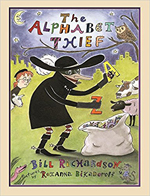 In the dark of night, the Alphabet Thief creeps through the city creating havoc as she steals letters from words in alphabetical order. As the letter “A” is stolen, boats become bots, fairs become firs, and coats become cots—and so on through the alphabet. The devious Alphabet Thief handles the Q-with-U predicament by removing them as a pair, so queasy is easy and squash becomes sash. Having nearly reached the end of the alphabet, the Alphabet Thief seems unstoppable until the red-headed narrator, who has been following her, makes slingshots with the letter Y and fires Zs at the thief. “A halo of Z’s encircles her head. / Such snoring as never been heard. / When I open her sack, the letters spring back / And hurry on home to their words.” The clever story in rhyme and playful ink-and-watercolor illustrations depicting word transformations make this small book one to add to my collection of alphabet books.
In the dark of night, the Alphabet Thief creeps through the city creating havoc as she steals letters from words in alphabetical order. As the letter “A” is stolen, boats become bots, fairs become firs, and coats become cots—and so on through the alphabet. The devious Alphabet Thief handles the Q-with-U predicament by removing them as a pair, so queasy is easy and squash becomes sash. Having nearly reached the end of the alphabet, the Alphabet Thief seems unstoppable until the red-headed narrator, who has been following her, makes slingshots with the letter Y and fires Zs at the thief. “A halo of Z’s encircles her head. / Such snoring as never been heard. / When I open her sack, the letters spring back / And hurry on home to their words.” The clever story in rhyme and playful ink-and-watercolor illustrations depicting word transformations make this small book one to add to my collection of alphabet books.
City Mouse, Country Mouse. Maggie Rudy. 2017. Godwin/Henry Holt.
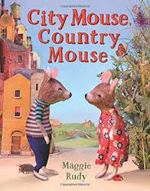 On a visit to the country, city mouse William Gray makes friends with Tansy Mouse and invites her to visit the city. “It’s so exciting! I could never live anywhere else!” Although she enjoys all there is to see and do in the city, Tansy is homesick and returns to the country. The city is too crowded and noisy for Tansy and the country is too quiet for William, but they miss each other. Their solution: settling in a small “halfway town,” where they live next door to each other and are close enough to both the city and the country to make visits. “And Tansy and Will, the best of friends, lived mousily ever after.” The illustrations for this retelling of one of my favorite Aesop’s fable are fascinating. Tansy, Will, and other characters are constructed with felt and positioned in sets created with found materials to create colorful, imaginatively-detailed scenes that are then photographed.
On a visit to the country, city mouse William Gray makes friends with Tansy Mouse and invites her to visit the city. “It’s so exciting! I could never live anywhere else!” Although she enjoys all there is to see and do in the city, Tansy is homesick and returns to the country. The city is too crowded and noisy for Tansy and the country is too quiet for William, but they miss each other. Their solution: settling in a small “halfway town,” where they live next door to each other and are close enough to both the city and the country to make visits. “And Tansy and Will, the best of friends, lived mousily ever after.” The illustrations for this retelling of one of my favorite Aesop’s fable are fascinating. Tansy, Will, and other characters are constructed with felt and positioned in sets created with found materials to create colorful, imaginatively-detailed scenes that are then photographed.
Little Fox in the Forest. Stephanie Graegin. 2017. Schwartz & Wade/Random House.
 Blue-toned panels in this wordless book show a young girl selecting a stuffed fox as her old and treasured item to take to school for show-and-tell. While she is playing on the swings at recess, a bright orange young fox sneaks up and runs off with the beloved toy fox. In a pursuit through the forest, she and a friend make inquiries of various animals (shown as colorful images in the blue scenes) and eventually come upon a fairy tale village of personified animals (shown in a brightly colored, double-page spread). Upon reaching the home of Little Fox, she is reunited with her toy fox—but not for long, as the ending panels reveal a surprise exchange. Little Fox in the Forest is my favorite wordless book of the year. There is more to discover with each rereading of the pictures in this beautifully crafted story.
Blue-toned panels in this wordless book show a young girl selecting a stuffed fox as her old and treasured item to take to school for show-and-tell. While she is playing on the swings at recess, a bright orange young fox sneaks up and runs off with the beloved toy fox. In a pursuit through the forest, she and a friend make inquiries of various animals (shown as colorful images in the blue scenes) and eventually come upon a fairy tale village of personified animals (shown in a brightly colored, double-page spread). Upon reaching the home of Little Fox, she is reunited with her toy fox—but not for long, as the ending panels reveal a surprise exchange. Little Fox in the Forest is my favorite wordless book of the year. There is more to discover with each rereading of the pictures in this beautifully crafted story.
Ages 9–11
Books! Books! Books!: Exploring the Amazing Collection of the British Library. Mick Manning & Brita Granström. 2017. Candlewick.
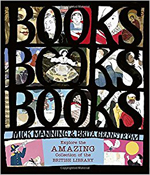 With a “Welcome to the greatest library in the world!” Manning and Grandström take readers on a tour of the British Library, the national library of the United Kingdom. Double-page spreads of watercolor-and-digital collage art incorporating photographic images of works from the library’s archives and a narrative presented in an informative, docent-like, conversational tone (with humorous touches) provide an engaging and accessible peek into the British Library’s treasure of books, documents, manuscripts, and more. Back matter includes notes on the 21 featured treasures, including the handmade St. Cuthbert Gospel, the oldest surviving book produced in Europe; the Magna Carta; the First Folio of William Shakespeare; and the original manuscript of Lewis Carroll’s Alice’s Adventures in Wonderland. I am interested in the history of books and I’d love to have the opportunity to explore the British Library, so I’m keeping Books! Books! Books!
With a “Welcome to the greatest library in the world!” Manning and Grandström take readers on a tour of the British Library, the national library of the United Kingdom. Double-page spreads of watercolor-and-digital collage art incorporating photographic images of works from the library’s archives and a narrative presented in an informative, docent-like, conversational tone (with humorous touches) provide an engaging and accessible peek into the British Library’s treasure of books, documents, manuscripts, and more. Back matter includes notes on the 21 featured treasures, including the handmade St. Cuthbert Gospel, the oldest surviving book produced in Europe; the Magna Carta; the First Folio of William Shakespeare; and the original manuscript of Lewis Carroll’s Alice’s Adventures in Wonderland. I am interested in the history of books and I’d love to have the opportunity to explore the British Library, so I’m keeping Books! Books! Books!
Lesser Spotted Animals: The Coolest Creatures You’ve Never Heard Of. Martin Brown. 2017. David Fickling/Scholastic.
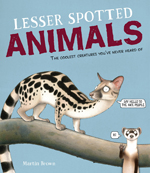 In the introduction, Brown sets the tone for this book with his “good-bye to the gnu and cherrio to the cheetah.” Each mammal (long-tailed dunnart, onager, gaur, zebra duiker, and 17 more) is given a heading with common name and an interest-catching identification (for example, “CUBON SOLENODON Shaggy Caribbean insectivore with a toxic bite”), a realistic portrait, and information about its characteristics and behavior. An inset provides information about size, diet, location, conservation status, and other trivia. The former science teacher in me loves finding books that I wish I had available when I was teaching. Thislively, informative book about lesser known mammals is also an interest-catching introduction about threats to the diversity of life on Earth.
In the introduction, Brown sets the tone for this book with his “good-bye to the gnu and cherrio to the cheetah.” Each mammal (long-tailed dunnart, onager, gaur, zebra duiker, and 17 more) is given a heading with common name and an interest-catching identification (for example, “CUBON SOLENODON Shaggy Caribbean insectivore with a toxic bite”), a realistic portrait, and information about its characteristics and behavior. An inset provides information about size, diet, location, conservation status, and other trivia. The former science teacher in me loves finding books that I wish I had available when I was teaching. Thislively, informative book about lesser known mammals is also an interest-catching introduction about threats to the diversity of life on Earth.
Ages 12–14
Gods and Thunder: A Graphic Novel of Old Norse Myths. Carl Bowen, Michael Dahl & Louise Simonson. Ill. Eduardo Garcia, Tod Smith & Rex Lokus. 2017. Capstone.
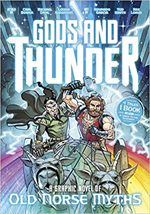 This introduction to Norse mythology in an accessible full-color graphic novel format includes four tales. In “Thor and Loki,” Thor (the son of Odin) and Loki (a sly, shape-shifting giant who has been raised with Odin’s children) journey into Jütunheim, the land of the giants. In “Thor vs. the Giants,” the thunder god outwits three giants in epic battles. “The Death of Baldur” tells the story of the tragic death of the beloved god of light, the son of Odin and Frigg. “Twilight of the Gods” chronicles the events of Ragnarök, the final battle that brings an end to the Nine Worlds. A glossary (with a pronunciation guide) is helpful in keeping track of the characters, places, and events in these ancient tales. I discovered Gods and Thunder while immersed in educating myself about graphic novels this year. It was the perfect book to get me prepped for reading Kevin Crossley-Holland’s Norse Myths: Tales of Odin, Thor, and Loki (2017) and Neil Gaiman’s Norse Mythology (2017), two other books I’m adding to my collection.
This introduction to Norse mythology in an accessible full-color graphic novel format includes four tales. In “Thor and Loki,” Thor (the son of Odin) and Loki (a sly, shape-shifting giant who has been raised with Odin’s children) journey into Jütunheim, the land of the giants. In “Thor vs. the Giants,” the thunder god outwits three giants in epic battles. “The Death of Baldur” tells the story of the tragic death of the beloved god of light, the son of Odin and Frigg. “Twilight of the Gods” chronicles the events of Ragnarök, the final battle that brings an end to the Nine Worlds. A glossary (with a pronunciation guide) is helpful in keeping track of the characters, places, and events in these ancient tales. I discovered Gods and Thunder while immersed in educating myself about graphic novels this year. It was the perfect book to get me prepped for reading Kevin Crossley-Holland’s Norse Myths: Tales of Odin, Thor, and Loki (2017) and Neil Gaiman’s Norse Mythology (2017), two other books I’m adding to my collection.
The Photo Ark: One Man’s Quest to Document the World’s Animals. Joel Sartore. 2017. National Geographic.
 This pictorial encyclopedia showcasing the diversity of animals on our planet features portraits of more than 400 animals. Working with captive animals, Joel Sartore photographed each species against a black or white background under controlled lighting to bring out details. Each photo is captioned with the common and the scientific name of the animal and a notation of the species’ conservation status. Inserts on eight “heroes,” conservationists acting to protect the Earth’s biodiversity, add interest. Back matter includes notes on the making of the photographs and National Geographic’s Photo Ark Project. This book goes right next to Animal Ark: Celebrating Our Wild World in Poetry and Pictures (2017), which includes a center double-page gatefold featuring National Geographic photographer Sartore’s animal portraits and “The Chorus of Creatures,” a poem by Kwame Alexander which celebrates connections between humans and the world’s wild animals.
This pictorial encyclopedia showcasing the diversity of animals on our planet features portraits of more than 400 animals. Working with captive animals, Joel Sartore photographed each species against a black or white background under controlled lighting to bring out details. Each photo is captioned with the common and the scientific name of the animal and a notation of the species’ conservation status. Inserts on eight “heroes,” conservationists acting to protect the Earth’s biodiversity, add interest. Back matter includes notes on the making of the photographs and National Geographic’s Photo Ark Project. This book goes right next to Animal Ark: Celebrating Our Wild World in Poetry and Pictures (2017), which includes a center double-page gatefold featuring National Geographic photographer Sartore’s animal portraits and “The Chorus of Creatures,” a poem by Kwame Alexander which celebrates connections between humans and the world’s wild animals.
Ages 15+
La Belle Sauvage (The Book of Dust #1). Philip Pullman. 2017. Alfred A. Knopf/Random House.
 Set 10 years earlier in the parallel world of Pullman’s His Dark Materials trilogy, Lyra Belacqua is a baby under the care of nuns in a priory on the Thames. In a devastating flood, 11-year-old Malcolm Polstead rescues Baby Lyra from the destroyed priory in his canoe, La Belle Sauvage. Swept far away in the storm, Malcolm faces a long and perilous journey to get Lyra back to safety in Oxford with the aim of securing sanctuary for her at Jordan College. I have been a Philip Pullman fan from the early 80s and enjoyed reading all of his books. I like to reread earlier books in a series before reading the latest book, so I’ll be reading La Belle Sauvage again before the second book in the Book of Dust series is published.
Set 10 years earlier in the parallel world of Pullman’s His Dark Materials trilogy, Lyra Belacqua is a baby under the care of nuns in a priory on the Thames. In a devastating flood, 11-year-old Malcolm Polstead rescues Baby Lyra from the destroyed priory in his canoe, La Belle Sauvage. Swept far away in the storm, Malcolm faces a long and perilous journey to get Lyra back to safety in Oxford with the aim of securing sanctuary for her at Jordan College. I have been a Philip Pullman fan from the early 80s and enjoyed reading all of his books. I like to reread earlier books in a series before reading the latest book, so I’ll be reading La Belle Sauvage again before the second book in the Book of Dust series is published.
Tool of War (Ship Breaker #3). Paolo Bacigalupi. 2017. Little, Brown.
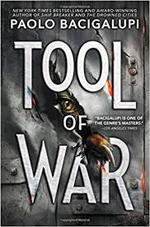 In this third book of master storyteller Bacigalupi’s post-apocalyptic series, Tool, a genetically engineered half man and half beast “augment” designed to be a fiercely obedient and loyal “killing machine,” has learned to suppress his inbred submissiveness to his masters. Aware of the potential for Tool to turn on his creators, General Caroa is using all of the powerful Mercier Corporation’s military resources to locate and destroy Tool, who is now set on a path of not only survival, but also revenge. Bacigalupi is the author who got me hooked on reading science fiction, and so this book joins my copies of the first two books in this series of dystopian thrillers: Ship Breaker (2011) and The Drowned Cities (2013).
In this third book of master storyteller Bacigalupi’s post-apocalyptic series, Tool, a genetically engineered half man and half beast “augment” designed to be a fiercely obedient and loyal “killing machine,” has learned to suppress his inbred submissiveness to his masters. Aware of the potential for Tool to turn on his creators, General Caroa is using all of the powerful Mercier Corporation’s military resources to locate and destroy Tool, who is now set on a path of not only survival, but also revenge. Bacigalupi is the author who got me hooked on reading science fiction, and so this book joins my copies of the first two books in this series of dystopian thrillers: Ship Breaker (2011) and The Drowned Cities (2013).
Victoria: Portrait of a Queen. Catherine Reef. 2017. Clarion/Houghton Mifflin Harcourt.
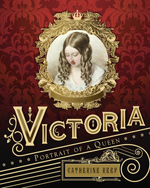 With a masterful storytelling voice, Reef offers readers a fascinating biography of Victoria, who became Queen of the United Kingdom of Great Britain and Ireland in 1837, at the age of 18, and ruled until her death in 1901. The engaging narrative, enriched by a wealth of illustrations (including full-color formal portraits and archival paintings) provides a vivid portrait of the long-reigning queen and a history of the era in which she lived. Back matter includes a list of British monarchs, Queen Victoria’s family tree, source notes, an extensive bibliography, picture credits, and an index. Victoria stays on my bookshelf because of my interest in the reign of Queen Victoria but also because the book is such a wonderful model of a well-researched and well-designed biography. Victoria: Portrait of a Queen is a book I’ll enjoy read again and looking at all the archival visual material. As a bonus, the bibliography will serve as a guide for learning more about the Victorian Era.
With a masterful storytelling voice, Reef offers readers a fascinating biography of Victoria, who became Queen of the United Kingdom of Great Britain and Ireland in 1837, at the age of 18, and ruled until her death in 1901. The engaging narrative, enriched by a wealth of illustrations (including full-color formal portraits and archival paintings) provides a vivid portrait of the long-reigning queen and a history of the era in which she lived. Back matter includes a list of British monarchs, Queen Victoria’s family tree, source notes, an extensive bibliography, picture credits, and an index. Victoria stays on my bookshelf because of my interest in the reign of Queen Victoria but also because the book is such a wonderful model of a well-researched and well-designed biography. Victoria: Portrait of a Queen is a book I’ll enjoy read again and looking at all the archival visual material. As a bonus, the bibliography will serve as a guide for learning more about the Victorian Era.
Carolyn Angus is former Director of the George G. Stone Center for Children's Books, Claremont Graduate University, in Claremont, California.
These reviews are submitted by members of the International Literacy Association's Children's Literature and Reading Special Interest Group (CL/R SIG) and are published weekly on Literacy Daily.